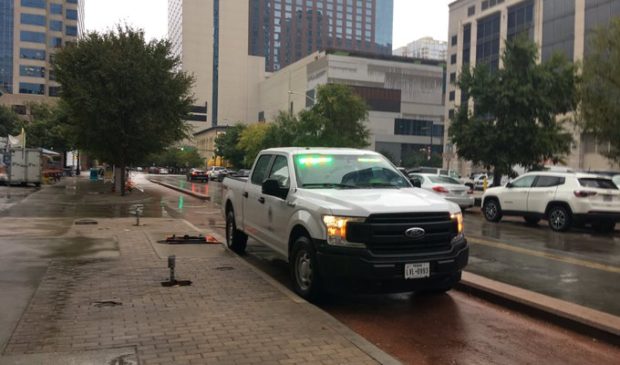Austin Transportation updates enforcement to keep bike lanes clear of cars
Wednesday, January 22, 2020 by
Ryan Thornton At least in theory, the Austin Transportation Department has long been able to ticket drivers for illegally parking in bike lanes. In practice, however, such enforcement has been inconsistent.
The Austin Transportation Department started making hires this week in an effort to change that. The department plans to address several weaknesses in the enforcement process so that drivers are ultimately discouraged from parking in a bike lane and cyclists can feel safe on city streets.
Until now, the department’s parking enforcement officers have had to balance clearing bike lanes with their other duties. A few months from now, however, the department hopes to have hired a dedicated team so that at least two bike lane enforcement officers can be dedicated to that specific task for any shift.
Transportation spokesperson Jacob Barrett said over email that these officers will be out patrolling across the city limits just like any other parking enforcement officer, but will be searching specifically for vehicles parked in bike lanes.
As is the case today, the effectiveness of the enforcement efforts will partly depend on how often the community reports violations, notifying an enforcement officer of the problem.
The department has included a new reporting tool in the city’s 311 reporting app to allow the public to report violations more easily.
Chris Riley, president of Bike Austin’s board of directors, said reporting was previously possible through the app but wasn’t very user-friendly. He added that the app has historically required individuals to provide a photograph that includes both the vehicle and a “no parking” sign, demonstrating that the specific bike lane actually prohibits parking.
The city’s general policy, Riley said, seems to be that parking in a bike lane is permitted unless stated otherwise.
Barrett said the department has been experimenting with increasing enforcement in recent months. In a pilot effort from October 2019 to this month, he said the department targeted specific “hot spots” where illegal parking is more of a problem, issuing around 70 citations and towing 17 vehicles parked in bike lanes.
Fines for parking in a bike lane can be as much as $300. Retrieving a towed vehicle on the same day of impoundment costs around $193.
The purpose of the pilot, Barrett said, was to see whether the additional enforcement would be a sufficient step to discourage drivers from parking in bike lanes.
The new parking enforcement team will continue to patrol around these hot spots as long as parking issues continue. At the same time, the department will be gathering data of reports to 311 in order to keep track of where new issues are appearing over time so that those areas can be better monitored.
Riley said he hopes the new enforcement system will no longer require individuals to give photographic proof of the vehicle in view of a no-parking sign, a potential barrier to reporting and enforcing issues. Doing so can be a frustrating challenge, Riley said, even along some of the city’s best-protected and most popular bike routes.
The decision to increase enforcement, Barrett said, was prompted by both community feedback as well as the city’s goal of eliminating traffic fatalities and serious injuries by 2025.
“This increased enforcement will allow bicyclists of all ages and abilities to enjoy our city’s bike network with less risk of being hit by a driver,” said Lewis Leff, Transportation’s safety officer. “Providing bicyclists with clear lanes of travel also improves predictability and order on our transportation network, which makes our streets safer for everyone regardless of their mobility preference.”
Riley said other steps need to be taken to ensure bike lanes won’t be blocked. Noting that vehicles are often gone before an enforcement officer can arrive on the scene, he said that protecting bike lanes with physical barriers that effectively make it impossible for a vehicle to pull into the lane is a good solution.
Overall, Riley said he’s optimistic the city is moving in the right direction but doesn’t expect a drastic surge in reporting under the updated app and new enforcement measures. Likely, he said, the same people who have been reporting will continue reporting.
Nonetheless, he said, this is clearly something the city needs to do if only to show people they are paying attention and striving toward systemic change.
Photo by Caleb Pritchard.
The Austin Monitor’s work is made possible by donations from the community. Though our reporting covers donors from time to time, we are careful to keep business and editorial efforts separate while maintaining transparency. A complete list of donors is available here, and our code of ethics is explained here.
You're a community leader
And we’re honored you look to us for serious, in-depth news. You know a strong community needs local and dedicated watchdog reporting. We’re here for you and that won’t change. Now will you take the powerful next step and support our nonprofit news organization?










